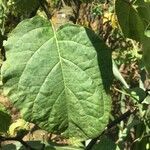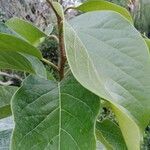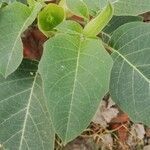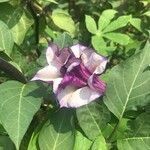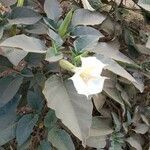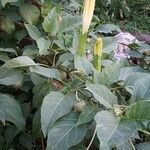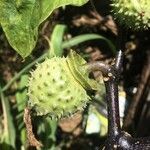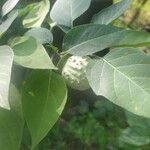Glabrate shrub to 2 m tall; twigs dark, purplish-colored (Panama). Leaves broadly ovate, to 15 cm long, margins subentire to repand-dentate, the base truncate or obtuse and oblique, the lamina with scattered small hairs; petioles slender, 3-8 cm long. Pedicels stout, erect or nodding, ca. 10 mm long, tardily deciduous at the base. Flowers with the calyx tubular, little or not inflated, slightly wider at base and apex, 3-8 cm long, opening by 5 subequal lobes 1-2 cm long, circumscissile near the base leaving a distinct flange 5-15 mm long, glabrous or puberulent with short, simple hairs, drying with prominent longi-tudinal veins; corolla showy white or purple, tubiform, the narrowly obconical
Corolla showy, white or yellow, purple or violet, sometimes purple or violet outside and whitish inside, 12–19 cm long, trumpet-shaped to ± tubular, simple or sometimes double or triple, sparsely pubescent, at least, or more densely, along the nerves, or ± glabrous; tube narrow, filling the calyx for half or a third of its length, with very short hairs scattered mainly below on the staminal region within; limb (3)6–10 cm across, sinuately 5-or 10-toothed or-lobed, the teeth or lobes ovate or ± triangular with a ± wide base and narrowing to the apex into an acute to long-acuminate tip up to 15 mm long, usually recurved, when 10, 5 shorter alternating with 5 longer ones.
Leaves solitary, the upper ones often geminate; petiole 1–8 cm long; lamina membranous or papyraceous, 4–24 × 2–20 cm, broadly to narrowly ovate or ovate-lanceolate, sometimes rhombic-ovate or elliptic, base cuneate to rounded or truncate, sometimes cordate, and oblique to dimidiate, often ± decurrent into the petiole, apex obtuse to acute or acuminate, entire or sinuate to coarsely dentate or lobed with a few, irregular, broadly triangular, obtuse to acute teeth or lobes, at first densely pubescent, later sparsely pubescent, more densely so on the nerves, to glabrous, the lateral nerves extending to the margin.
tube filling the calyx, 8-20 cm long, the limb sometimes double or triple, flaring to 3-10 cm across, sinuately 5-lobed with 5 or 10 linear teeth; filaments glabrous, sometimes connate or apically appendaged, anthers ca. 10 mm long; ovary short-conical, style glabrous. Fruit ovoid or elliptical to 4 cm long, splitting irregularly, covered with conspicuous tubercles or soft, stout teeth, 4-loculed, many seeded, nodding to somewhat upright but not strictly erect; seeds flattened, reniform, ca. 5 mm long, with a small fleshy aril.
Calyx (3.5)4–7.5(8.5) × (0.8)1.1–4 cm, ± 5-angled or slightly 5-ribbed, subdensely pubescent to glabrous, sometimes hairy along margins of lobes and midvein inside, drying with prominent longitudinal nerves; tube little or not inflated and slightly wider downwards and upwards; lobes subequal, (0.4)0.7–2.4 × (0.3)0.4–0.9 cm, ovate to triangular-lanceolate, acute to long-acuminate; in fruit the flange up to 15 mm wide, appressed to the fruit or ± reflexed.
Fruit somewhat upright to nodding, reddish-brown or purplish when ripe, 3–3.8 × 2.4–3.3 cm including spines, ovoid or ± globose, with walls up to 4 mm thick, covered with few–many, stout, conical spines 2.5–8 mm long or tubercles, densely and shortly pubescent to ± glabrous, irregularly breaking up.
Seeds whitish, yellowish-brown or brown, 4–6 × 4–5 × 1.4 mm, subcircular, ovate to obovate in outline, or sometimes ± reniform, strongly thickened and longitudinally ridged at the border, finely tuberculate to almost smooth; caruncle small, fleshy.
A sp. of uncertain geographic origin, is rarely adventive in waste places. It has glabrous to subglabrous herbage, coarsely few-toothed, basally truncate to broadly cuneate lvs with a few large coarse teeth on the margins, and a 10-lobed cor-limb.
Stamens (4)5, included, rarely subexserted; filaments adnate to above the middle of the corolla tube and with a few white, relatively wide, short hairs, free upwards for 3.5–5(7) cm and ± glabrous; anthers 10–17.5 mm long, linear in outline.
Annual herb, up to 1.5 m or higher. Pedicels up to 10 mm long. Calyx up to 50 mm long. Corolla 160-180 mm long. Fruit tubercled or covered with short spines, densely short strigose-pubescent. Flowers white, yellow or purple.
A herb or short lived shrub. The leaves are large and oval. They have irregular edges. The flowers are long and trumpet shaped. They are light yellow or white. The fruit are rounded and have short thorns. POISONOUS.
Flowers solitary or rarely 2 together, terminal or lateral, at first erect, later drooping; pedicel 5–11 mm long, stout, ± densely pubescent mainly towards the base and near the calyx, in fruit elongated to 20 mm.
Ovary up to 8 × 8 mm, shortly conical, with short (or rarely longer and thinner) appendages, very shortly pubescent or ± glabrous; style 11–13(17.5) cm long, straight, glabrous.
Erect or occasionally decumbent herb or shrub, (0.2)0.6–2(3.5) m high, sometimes ± bushy, sometimes tinged purple or violet.
Branches striate and ± sulcate, glabrous to ± densely pubescent especially when young.
White or wine-purple, sometimes (in cultivation) double flowers.
Habit of the last (Datura innoxia), 2-3 ft. high
